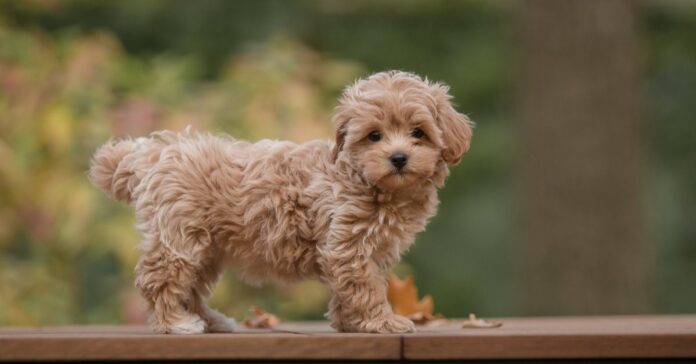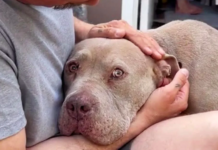Last Updated on September 11, 2021 by Fumipets
Even those who aren’t especially fond of tiny dogs may be completely captivated by a cute Maltipoo.
What’s not to love? Both the Maltese and the Poodle are kind, lively, low-shedding, and intelligent dogs. When you combine the two, you get the perfect small companion dog.
How big do Maltipoos get? Maltipoos range in size from 3 to 18 pounds and 6 to 14 inches tall, depending on their parents’ size. Most will weigh between 7 and 14 pounds and stand between 8 and 12 inches tall at the shoulders.
The size of an adult Poodle is mostly determined by whether a toy or miniature Poodle was utilised.
Maltipoos, like many crossbreeds, come in a wide range of sizes. Read on to see why and when you may expect them to mature fully.
How Big Will A Maltipoo Grow To Be?
While no one can estimate how large a Maltipoo will grow, most will reach adulthood weighing between 7 and 14 pounds and standing between 8 and 12 inches tall at the withers (top of shoulders).
Genetics have a significant influence in predicting future adult size, just as it does in humans.

Size Of Parents
A Maltipoo, as you may know, is a cross between a Maltese and a Poodle, both of which are tiny dogs.
What you may not realise is that, although the parent Poodle is typically a toy type, tiny Poodles have played a role in the development of this designer breed.
It goes to reason that the bigger the parents, the bigger the pups will be, and this is often the case.
A brief look at the normal sizes of the breeds that go into creating the beautiful Maltipoo will help you understand why size may vary in this designer breed.
Maltese
A Maltese should weigh less than 7 pounds and stand between 7 and 9 inches tall, according to the American Kennel Club (AKC) breed standards.
There’s not a lot of leeway here since the breed’s standards (which date back to about 1500 B.C.) have been in existence for a long time and are very well established.
Toy Poodle
Toy Poodles must weigh between 4 and 6 pounds and stand no more than 10 inches tall at the shoulder, according to the AKC.
Adult Toy Poodles that are overweight or the result of bad breeding methods fall outside of this range.
Miniature Poodle
Miniature Poodles must weigh 10 to 15 pounds and stand less than 15 inches tall to fulfil breed requirements. This range should not be strayed too far by well-bred dogs.
It’s easy to understand how incorporating a Miniature Poodle into a Maltipoo breeding programme would have a significant impact on the size of the pups.
Because of the complicated world of genetics, Maltipoos with a Miniature Poodle in their lineage may still have a bigger size many generations down the road.
The F1 generation refers to puppies produced by mating a purebred Maltese with a purebred Poodle.
Although these pups have a striking resemblance to one parent, they have the characteristics of the other.
Not all pups in an F1 litter will have the same appearance.
Some may, but others may seem to be exact replicas of one parent and not at all resemble a mixed breed.
When an F1 is bred back to a parent breed, the resultant litter is known as the F1B generation, and the parent breed’s characteristics and traits are amplified.
The F2 generation is created by crossing two F1s. F2B puppies are produced when an F2 is mated back to a parent breed or when an F1B is bred to an F1.
F3 pups may be produced by breeding two F2 generation dogs, which can subsequently be backcrossed to a parent breed to achieve an F3B classification.
Multi-generational is a term used to describe generations F3 and above.
The more generations of Maltipoos a breeder has dealt with, the more precisely he or she can estimate the mature size of the pups.
However, it may take several generations for Maltipoos to become fully standardised, particularly if a Miniature Poodle was ever included in the mix.

Impacts More Than Just Size
It’s important to remember that dog size isn’t the only factor that generation influences. It also affects how much or how little the dog sheds, as well as the kind of coat he has.
When do Maltipoos become fully mature?
Physical, mental, and sexual maturity are the three components of adulthood, and each is achieved at a distinct age.
Only until each of these characteristics has been fully fulfilled will a Maltipoo be deemed totally grown.
Physical Maturity
The skeletal system of a Maltipoo matures between 10 and 12 months of age, although many dogs develop fat and muscle until they are 18 months old.
They should cease developing after that.
Mental Maturity
As a Maltipoo approaches adulthood, mental maturity develops gradually.
Puppy-like behaviour usually fades shortly before the one-year mark, although it may take many months for it to completely vanish.
Sexual Maturity
Maltipoos may exhibit indications of sexual maturity as early as 4 months old, due to the fact that tiny breeds develop somewhat quicker than bigger breeds.
Both males and females are typically capable of reproducing by the age of six months.
Are There Different Size Classifications For Maltipoos?
When searching at Maltese breeders, you’ll quickly see that some categorise their Maltipoos as teacup, toy, or tiny, and the weight restrictions they employ to classify them differ.
Teacup is often added to the description as a marketing tactic, despite the fact that it is inaccurate and even deceptive.
So, what exactly do these words imply, and do they relate to Maltipoos?

Teacup
This phrase is used to describe dogs who weigh less than 4 pounds.
Teacups are often created by mating two extremely tiny dogs, generally the runts of two litters, and are prone to a variety of health problems.
The word “teacup” is not recognised by the American Kennel Club as a size categorization.
Toy
Dogs are classed as “toy” dogs if they weigh less than 10 pounds. Many Maltipoos, particularly those advertised as “teacups,” come under this category.
Miniature
This word, which some breeders refer to as tiny and others as medium, refers to dogs that weigh between 10 and 25 pounds.
This group would include Maltipoos on the heavier end of the spectrum.
You may get a rough estimate of your puppy’s mature size by looking at both the father and mother of the litter you’re interested in.
Whatever term the breeder uses, you can be sure that your new Maltipoo will be tiny, weighing in at under 20 pounds when fully grown.

What And How Often Should I Feed A Growing Maltipoo?
Smaller dogs, such as the Maltipoo, have a faster metabolic rate than bigger dogs.
This implies their little bodies need more calories per pound and will benefit from a diet tailored to their particular requirements.
If you feed your puppy a reliable, name-brand kibble designed for tiny breed pups, he will get the right quantity of essential nutrients every day.
Choose foods with typical meat as the first component, such as chicken or lamb. Feeds with fillers or dubious substances, such as synthetic preservatives, should be avoided.
Puppies in active growth should be given three or four small meals each day.
Follow the instructions on your feed manufacturer’s website for the suggested daily serving size and divide it into three or four pieces.
A nice lunchtime schedule would be to take your Maltipoo for a walk or engage him in some puppy playing, then let him eat in peace before heading outside for bathroom time.


















